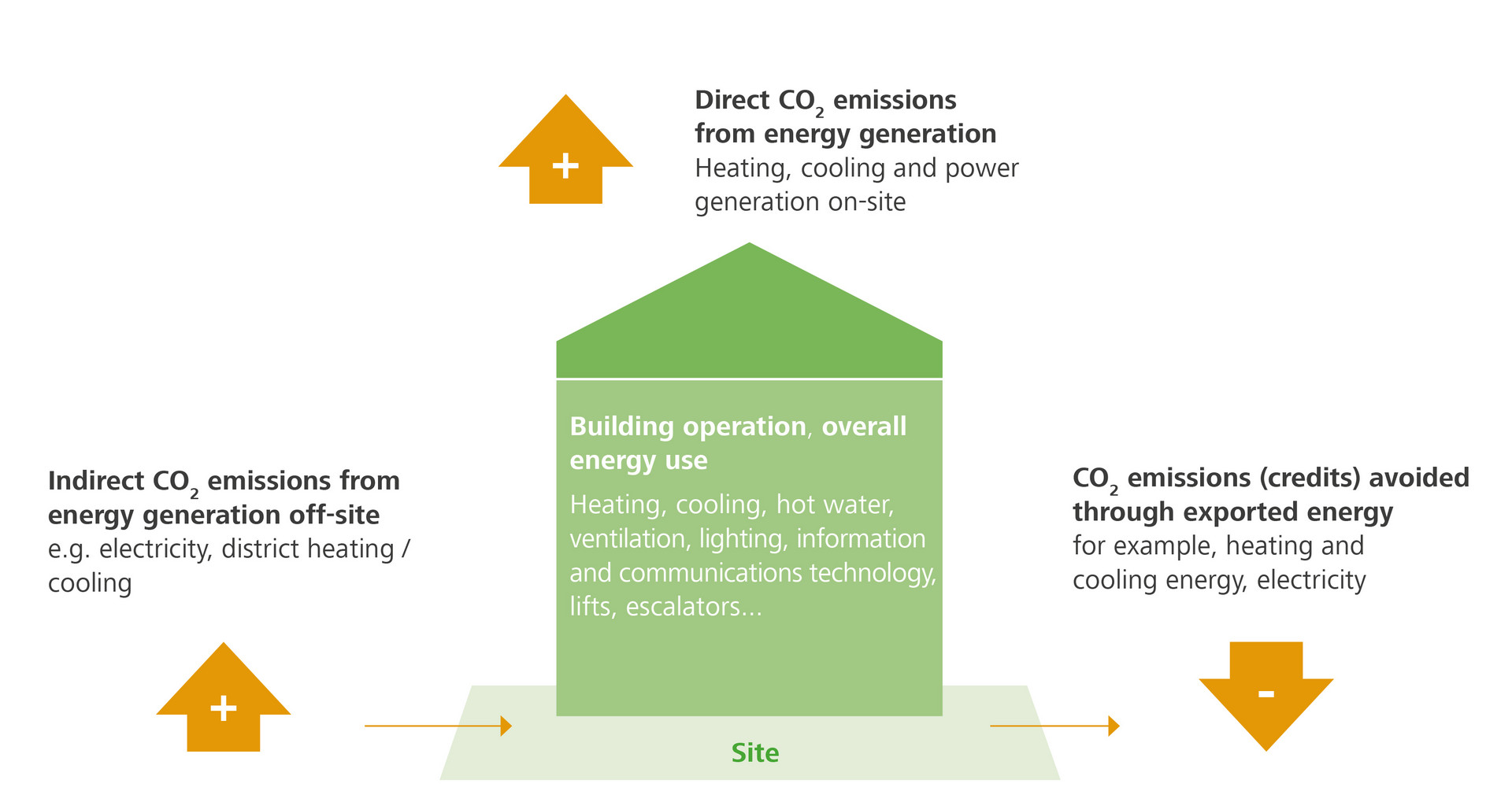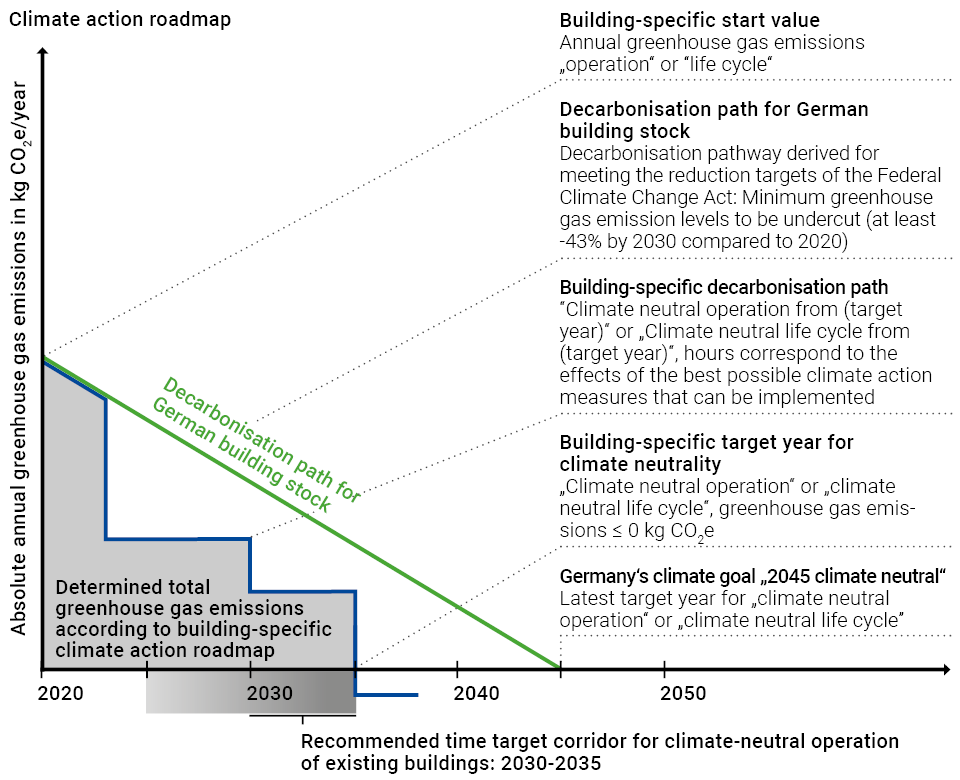The DGNB's Framework for carbon neutral buildings and sites makes a significant contribution to making the decarbonisation of the building stock by 2050 practically feasible. The current version of August 2020 is based on an initial version published in 2018, the methodology of which was evaluated in numerous projects.
What is the Framework?
In the Framework, the DGNB has compiled its definition of carbon neutrality and the associated explanations regarding procedures and strategies. The aim of the document is to create clarity in the market and to educate all stakeholders involved in the planning, construction, operation and management of real estate with regard to effective optimisation approaches for reducing greenhouse gas emissions.
Specifically, the Framework describes comprehensive, practically applicable rules for balancing the CO2 emissions of buildings and sites. Based on the definitions formulated there for carbon neutrality in the operation and construction of buildings, the Framework provides the basis for developing building-specific climate action strategies. The basis for this is provided by individual climate action roadmaps, as presented in the Framework. In six steps, it is shown how each building arrives at its specific action plan, which will take it along the most economical path to carbon neutrality by 2050 at the latest.
The Framework also provides assistance for the concrete implementation and evaluation of the measures derived from the strategy and defines the Framework for corresponding CO2 reporting.
Structure and content of the Framework
The Framework describes in detail the following four basic elements of a climate action strategy:
The CO2 account for real estate as well as the associated policy allows a precise evaluation of the current greenhouse gas emissions of buildings based on the measured consumption data. In this way it provides the foundation for determining actual action requirements on the path to carbon neutrality. A solid decision foundation is required in order to minimise the risk of investing into stranding assets. This means that CO2 accounting must be sufficiently meaningful in order to depict the actual greenhouse gas emissions as fully as possible.

Sections from part 1 of the Framework:
- Preliminary remarks and constraints
- Basic principles of Carbon accounting
- Accounting scope and accounting rules
- Data collection for CO2 accounts
- Usage and deductibility of renewable energy suppliers
- CO2 compensation
- Credits from energy export
- Reliability of the results and data quality indicator
- CO2 emission factors
- Calculation tools for determining the energy demand and greenhouse gas emissions
- Accounting documentation and quality assurance
- Outlook
Climate action and the associated investments must be planned in a focused manner. Only those who define clear objectives for their buildings, sustain these and implement measures in a future-orientated manner can optimally combine climate action and economic viability. It is important here that this is carried out for each building individually. This is the only way in which valid measurement plans can be developed which are designed with a focus on the specific conditions.

Sections of part 2 of the Framework:
- Target and benefits of Climate Action Roadmap
- Basic principles
- Creation of a Climate Action Roadmap
■ Step 1: Determining the initial condition
■ Step 2: Potential analysis for relevant focus areas
■ Step 3: Cost assessment of the measures
■ Step 4: Time planning of the measures and determining the targets
■ Step 5: Documentation and quality assurance of the creation of a Climate Action Roadmap
■ Step 6: Determining responsibilities and planning the first implementation steps
Many stakeholder groups of actors are interested in the key figures relating to building CO2 emissions: Building owners, planners, managers, investors, financial experts, political decision-makers as well as clients, employees and residents. The information which flows into rental and purchasing decisions acts as evidence to financial backers or proves the effectiveness of the climate action measures implemented. A structured format for the transparent, regular communication of this key metric forms a climate action passport.
Sections of part 3 of the Framework:
- Climate action management on the basis of the Climate Action Roadmaps
- Communication of climate action relevant information
- Climate action-relevant information in external reporting
It is necessary to verify a site independently in order to reliably check whether the implemented climate action measures are actually effective and the set goals have been met. There are different external quality assurance methods available depending on whether the optimisation measures in the operation of a building concern an entirely new construction or a comprehensive renovation. The award associated with this together with a certificate create transparency and strengthen the credibility.
Sections of part 4 of the Framework:
- Quality assurance for reliable target achievement
- Incentives for more climate action with DGNB Certifications
Link of the Framework to DGNB Certification
The DGNB System can be understood as an incentive to apply the Framework and put climate action into practice. The various forms of DGNB Certification offer different starting points and motivations for dealing with climate action requirements. These include, for example, the planning and execution of new buildings or renovations with low CO2 emissions from construction or carbon neutral building operation.
Particularly in the DGNB System for Buildings in Use, which was fundamentally revised in 2020, the climate action requirements are closely coordinated with the Framework. For example, the regular monitoring and reduction of CO2 emissions as well as the creation and application of individual climate action roadmaps, as specified in the Framework, are addressed. Buildings that are demonstrably operated in a carbon neutral manner based on their real consumption data can receive the DGNB Climate Positive award.
Further sources related to the Framework
In parallel with the 2020 version of the Framework, the DGNB has published "Climate Positive: Now! How every building can contribute to climate action". This provides more detailed background information on why the construction and real estate sector plays a central role in climate action and why a paradigm shift is needed in the way we deal with our buildings. It also identifies fields of action that have a significant influence on making buildings climate neutral.
The DGNB has also published a toolbox as part of the "WiTraBau" project (From the German: "Wissenstransfer Bau: Wissensplattform für die Transformation zu einem klimaneutralen Gebäudebestand" meaning "Knowledge Transfer Construction: Knowledge Platform for the Transformation to a Climate Neutral Building Stock"). Among other things, it contains tips on the detailed application of the framework as well as valuable tools for calculating CO2 balances. In addition, buildings that are already being operated in a climate-positive manner are presented as case studies.
Your Contact


